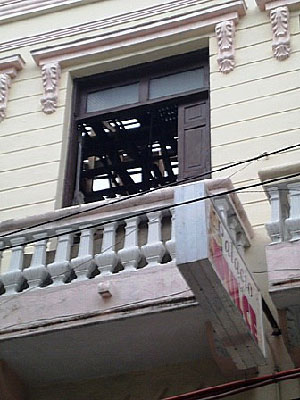Santiago de Cuba Six Months after Hurricane Sandy
A Good Import Substitution Strategy
By Dariela Aquique (Photos: Janis Hernandez)

HAVANA TIMES — Many people have taken an active interest in seeking out information about the real situation that the inhabitants of Santiago de Cuba have faced since hurricane Sandy lashed the province in October of last year.
Those who live far from the city aren’t fully satisfied with the news offered by Cuba’s official media. My colleague and I, who live in Santiago de Cuba, have been asked to talk about the situation here.
She agreed to do a photo journalism piece, while I took on the informative post. I’ll start by saying that the city did experience a prompt – though by no means complete – recovery.
Most donations received from abroad, particularly building materials, have been destined to State institutions which suffered damages during the hurricane, chiefly schools and hospitals. As I write this report, however, one can still observe facilities of this nature around the city where no repair work of any kind has been undertaken.
Homes, the most widely damaged structures, are seeing, and will likely continue to see, the slowest repair efforts.
Construction brigades made up of locals and Venezuelan workers are erecting three and four story apartment buildings around the city, to house families whose homes were partially or totally destroyed by the hurricane. Priorities are decided on the basis of the damages suffered and the characteristics of the family affected.
Families with children, elderly or disabled relatives, or very low-income homes, are first on the list for these apartments.

That said, some have complained about this process. Others have said that construction work has been slow. Yet others that the apartments lack the required quality. There is talk of red tape and favoritism in deciding who gets the new housing.
There are those, too, who report that building materials have been misappropriated, or sold on the black market.
What truly angered residents of the province, however, was the distribution of the food products donated by countries around the world in a show of solidarity towards Cuba.
Grains and cereals, such as rice and beans, were sold at different locations at very reasonable prices during the first two months following the hurricane.
Frozen and canned products, however, were made available to the population at the province’s Ideales stores, at hair-raising prices.
Most of the canned foods sold to families during the first days after the disaster (exclusively meats) were nearing their expiration date, causing much anger among Santiago de Cuba residents.
Despite these irregularities, the city looks to have recovered considerably and people are, as usual, “fairly pleased” with the repair efforts, though there’s no shortage of negative comments and complaints at bus stops, store queues and just about anywhere people talk.
Referring to everything that had ensued since the hurricane, an elderly gentleman remarked: “Well, Cuba got a fair amount of gifts from abroad and the State profited from that…Sandy was a good import substitution strategy.”
Click on the thumbnails below to view all the photos in this gallery. On your PC or laptop, you can use the directional arrows on the keyboard to move within the gallery. On cell phones use the keys on the screen.






















As a witness of Sandy’s massive destruction, everyone should commend and learn from the effective and immediate response of the local, national government, civil defense, military, social and political organizations coordinated salvage and rescue efforts around the clock, clearing roadways, removing debris, providing temporary shelter, food, healthcare, clothing to everyone in need.
Unfortunately billions of tons of wood from demolished buildings and tens of millions of ravished trees, were not used to be converted into vegetable coal, which could have provided fuel for hundred of thousands of homes.
A grave and unforgiveable blunder was the sale of many donated construction material and foodstuff, which became the most serious irritant and cause for widespread protest in various communities and which may have left some longstanding ill feelings among many victims.
Likewise, many solidarity groups willing to provide assistance were turned-off by a thick bureaucratic machinery, which made the reception and distribution of donations much more difficult than moving it across oceans.
Santiago de Cuba needs the immediate creation of 100,000 jobs to begin to deal with the prevailing human despair, family breakdown and the eventual increase in crime, as it has been accurately stated in numerous articles, conferences and symposiums, dealing with the pervasive poverty, marginalization, segregation and a resurgent racism in the country.
Encourage and make easy the involvement of thousands of sons and daughter of these ravished communities living abroad, interested in helping their peers, by supporting the creation of small ventures, farming or sending tools, equipment or machinery, impeded by a cumbersome, outdated Custom regulations, bent on stopping the entrance of goods and services to the country.
A grave